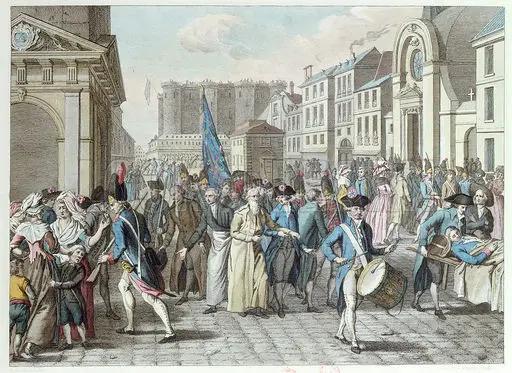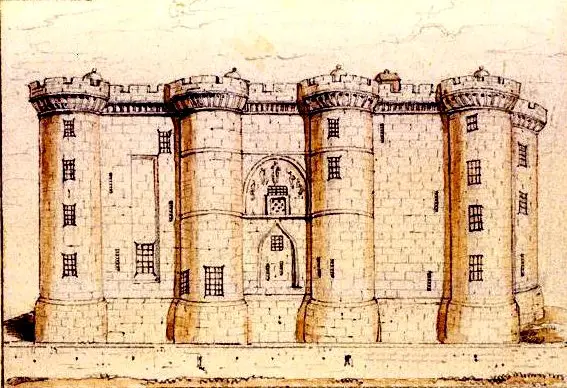Bastille Day ( July 14 ) is the French National Holiday. On this day in 1789, there was an incident of the storming of the fortress, the Bastille.
The Bastille was a fortress which was built by Hugues Aubriot, to protect the city of Paris from the attacks of foreign nations during the Hundred Year’s War. It was made the state prison later in 1417.
It was attacked and stormed by the Parisian Mob for the massive amount of gunpowder that was stored in the Bastille.
This day symbolizes the beginning of the French Revolution. Since then many remarkable events took place like feudalism was abolished and the french republic replaced the monarchy.
Here are the 10 interesting facts about the Storming of the Bastille and Bastille Day.
10. Bastille was attacked on July 14, 1789
Content

Bastille, a fortress in Paris which was known formally as the Bastille Saint- Antoine, was used by the kings of France as a state prison. It had about 250 barrels of gunpowder which were transferred to the Bastille on 12th July.
The armed crowd started gathering around the Bastille on the morning of July 14, 1789. They were demanding for gunpowder and surrender of the state prison.
State Prison did not agree to the demands of the revolutionaries and negotiations went on for hours. The armed crowd impatiently invaded into the courtyard and started attacking the Bastille.
With the invasion, the crowd started fighting and firing. It ultimately made governor of the Bastille, Bernard-Rene de Launay to surrender in front of the revolutionaries.
9. Bastille was attacked by gunpowder

On the day of the attack, Bastille had 250 barrels of gunpowder( about 13,600 kgs), arms-ammunition, and few prisoners.
Parisians were in great fear that the royal army was planning an attack against them. So, they gathered a crowd with about 32,000 muskets which were without the gunpowder.
They were eyeing for the weapons and gunpowder that was stored in the Bastille. So, the Parisian mob attacked the Bastille, not for the seven prisoners but for the gunpowder and weapons they had there.
By the end of the attack, the governor Launay surrendered the prison and handed over the large quantity of gunpowder to the Parisian mob.
8. Bastille had seven prisoners on the day of the attack

Bastille was the state prison for the kings of France. It was also used to store arms and ammunition. Anyone who disobeyed the king would be imprisoned without any trial in the prison of Bastilles.
Primarily prisoners were mostly from the upper-class, but later it was made the state prison. Total of 5,279 prisoners was imprisoned in the state prison by 1789.
On the storming of the Bastille Day (July 14, 1789), there were only seven prisoners in the Bastille.
Out of those seven: two were mad-men, one was a nobleman, and four were forgers. The revolutionary crowd, Parisian mob released all those prisoners.
7. Marquis de Sade might have helped the attack of the Bastille

Marquis de Sade was a nobleman, aristocrat, politician, writer and philosopher. He was imprisoned for 30 years in different prisons and asylums due to his scandalous writings.
Marquis had spent 10 years in the prison of the Bastille. Few weeks prior to the attack, he was imprisoned again in the same prison.
Out of the pissing tube, a megaphone was designed by Marquis. He used it to spread a message to the people who were outside of the Bastille. He started asking for help to free the prisoners as they were being massacred inside.
Due to this behaviour, governor Launay transferred him to Charenton, an asylum, to treat his mental illness.
6. Thomas Jefferson financially helped revolutionaries

Thomas Jefferson was the U.S. Ambassador to France at the time of the Storming of the Bastille. He witnessed the attack and made a record of it in detail and sent it to John Jay, Secretary of Foreign Affairs.
Jefferson showed sympathy towards the revolutionaries. Lafayette was helped by him while drafting the Declaration of the Rights of Man. He supported France and the revolution for long.
Jefferson gave 60 francs to the widows of those who were killed in the storming of the Bastille. He had mentioned about the help in his diary.
5. It ignited the French Revolution

Bastille Day marks the start of the French Revolution and the end of the Ancien Regime. Before Bastille Day, France was under the system of monarchy and aristocrats. This was since the 15th Century.
After storming of the Bastille, various other events took place including Feudalism was abolished on 4th of August, a new right – Declaration of the Rights of Man and the Citizen was declared on 26th of August, Women started marching on Versailles on the 5th of October to raise voice against the price rise of the bread, and there was a Declaration of the Rights to the Women and the Female Citizens.
Along with the fall of the Bastille came various other events like an attempt of the fleet of royal family and execution of the royal couple were remarkable.
4. Bastille day is the French Independence Day

The day when an armed crowd stormed the Bastille, July 14, is the French Independence Day or the French National Day.
14th July is considered the anniversary of the Storming of the Bastille and celebrated by the French people all over France.
There are various art festivals, public celebrations, dances, fireworks, along with an oldest military parade on this day. The show starts from the Arc de Triomphe to the Place de la Concorde.
The French Republic President, foreign ambassadors, and government officials are present there to witness the parade. All of these celebrations are broadcasted on TV.
3. The First Prisoner built the Bastille

Bastille was built in 1357 as a fortress and was known as Bastille Saint-Antoine. A capable administrator, Hugues-Aubriot made it. Later, during the 14th Century, it was turned into the eight-storied building to guard Paris.
Hugues Aubriot, the mayor of France, was responsible for arresting citizens who were harassing the Paris’ Jews. He was charged with crimes including sodomy, extortion, heresy, and mainly for protecting Paris’ Jewish Population.
Aubriot was imprisoned for life on bread and water. There were disturbances in Paris during this period so, a mob rebelling against taxation broke into this prison and released Aubriot.
Ironically, the person who built the Bastille (the state prison) became the first person to be imprisoned there.
2. Model Souvenirs were made out of pieces of the Bastille

After the storming of the Bastille, the stones and pieces were turned into various Model Souvenirs.
Owner of a construction company, Francois Palloy, tore down the stones and demolished the prison(July 6) with the permission of New Assembly.
Various model souvenirs can be found today that are made from the remainings of the Bastille including:
- Model Carved at the Musee Carnavalet is made from the original stone.
- Various Medals and other objects at the Musee Carnavalet are made from the chains of the prisoners.
- A severely damaged stone from the Bastille is at the wall of the old castle of Thonon-Ies-Bains.
- Another Bastille stone with a copy of the Declaration of the Rights of the man is at the Hotel de Ville. Paris.
- Bastille clock bells and pulley system is at the Musee d’Art Campanaire
- Bastille metro platform has the walls outlined by the original moat walls
- Paving stones of the Bastille can be seen at Rue Saint Antoine, where Bastille was initially located
1. Bastille day military parade- the oldest military parade in the world

Bastille day military parade starts from the Arc de Triomphe and ends at the Place de la Concorde on July 14.
The parade started from 1880 as the National Day Parade and is marched on the morning of 14th July every year.
The regular French parade involves about 300 vehicles, 7,000 soldiers, 800 helicopters-planes, and 240 horses. It is the largest and the oldest military parade in the whole world.
The Bastille parade is witnessed by the French Republic President, government officials, and foreign affairs and is broadcasted on the French TV. Massive concert with various stage performances is also organised in the evening of this day.
Conclusion:
The storming of the Bastille was on the 14th of July, 1789. It happened because of the gunpowder and the arms that were stored there. The Bastille Day ignited the French Revolution by ending the monarchy.
The citizens were in fear that the royal army would be attacking them, so they decided to attack the state prison.
The Parisian mob gathered in front of the Bastille and started demanding for the gunpowder and the surrender of the prison.
This day is celebrated as the French Independence Day with various activities and the world’s largest and oldest military parade.
